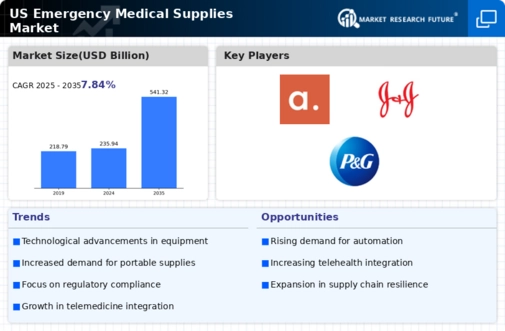Growing Aging Population
The demographic shift towards an aging population in the U.S. presents a compelling driver for the emergency medical-supplies market. As individuals aged 65 and older are projected to account for nearly 20% of the population by 2030, the demand for medical supplies tailored to this demographic is expected to increase significantly. Older adults often require specialized emergency medical supplies, including mobility aids, home healthcare products, and emergency response systems. This demographic trend necessitates a proactive approach to emergency preparedness, prompting healthcare providers and families to invest in appropriate supplies. Consequently, the emergency medical-supplies market is likely to see a surge in demand for products that cater specifically to the needs of the aging population, thereby shaping the future landscape of the industry.
Rising Demand for Preparedness
The emergency medical-supplies market experiences a notable increase in demand driven by heightened awareness of the necessity for preparedness in various sectors. This trend is particularly evident in healthcare facilities, where the need for essential supplies such as first aid kits, defibrillators, and personal protective equipment has surged. According to recent data, the market is projected to grow at a CAGR of approximately 6.5% over the next five years, reflecting a growing recognition of the importance of having adequate emergency supplies readily available. This rising demand is not only limited to hospitals but extends to schools, workplaces, and public venues, indicating a broader societal shift towards prioritizing emergency readiness. Consequently, manufacturers are compelled to innovate and expand their product lines to meet this evolving demand in the emergency medical-supplies market.
Focus on Training and Education
The emphasis on training and education within the healthcare sector significantly impacts the emergency medical-supplies market. As organizations recognize the importance of equipping personnel with the necessary skills to respond effectively in emergencies, there is a growing demand for training programs that incorporate the use of emergency medical supplies. This trend is evident in various settings, including hospitals, schools, and corporate environments, where training sessions on first aid and emergency response are becoming increasingly common. The investment in training not only enhances the preparedness of individuals but also drives the need for a diverse range of medical supplies to support these initiatives. Consequently, the focus on training and education is likely to remain a key driver for the emergency medical-supplies market, fostering a culture of readiness and resilience.
Technological Advancements in Medical Supplies
Technological advancements play a pivotal role in shaping the emergency medical-supplies market. Innovations such as telemedicine, smart medical devices, and advanced diagnostic tools are revolutionizing the way emergency care is delivered. For instance, the integration of mobile health applications allows for real-time monitoring and management of patients, enhancing the effectiveness of emergency responses. Furthermore, the development of portable medical devices, such as compact defibrillators and automated external defibrillators (AEDs), has made emergency medical supplies more accessible and user-friendly. As technology continues to evolve, it is anticipated that the emergency medical-supplies market will expand to incorporate these advancements, ultimately improving patient outcomes and response times in emergency situations.
Increased Investment in Healthcare Infrastructure
Investment in healthcare infrastructure significantly influences the emergency medical-supplies market. As the U.S. government and private entities allocate more resources towards enhancing healthcare facilities, the demand for emergency medical supplies is expected to rise correspondingly. Recent reports indicate that healthcare spending in the U.S. is projected to reach $4.3 trillion by 2025, with a substantial portion dedicated to upgrading emergency response capabilities. This investment encompasses not only physical infrastructure but also the procurement of advanced medical supplies, thereby bolstering the emergency medical-supplies market. Enhanced infrastructure facilitates better emergency response times and improves overall patient outcomes, which in turn drives the need for a diverse range of medical supplies. As such, the ongoing investment in healthcare infrastructure is likely to remain a critical driver for the emergency medical-supplies market.

















Leave a Comment